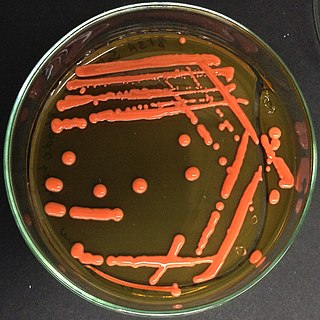
Rhizobium is a genus of Gram-negative soil bacteria that fix nitrogen. Rhizobium species form an endosymbiotic nitrogen-fixing association with roots of (primarily) legumes and other flowering plants.
Uranium (92U) is a naturally occurring radioactive element that has no stable isotope. It has two primordial isotopes, uranium-238 and uranium-235, that have long half-lives and are found in appreciable quantity in the Earth's crust. The decay product uranium-234 is also found. Other isotopes such as uranium-233 have been produced in breeder reactors. In addition to isotopes found in nature or nuclear reactors, many isotopes with far shorter half-lives have been produced, ranging from 214U to 242U. The standard atomic weight of natural uranium is 238.02891(3).

Beauvericin is a depsipeptide with antibiotic and insecticidal effects belonging to the enniatin family. It was isolated from the fungus Beauveria bassiana, but is also produced by several other fungi, including several Fusarium species; it may therefore occur in grain contaminated with these fungi. Beauvericin is active against Gram-positive bacteria and mycobacteria, and is also capable of inducing programmed cell death in mammals.

Rhodotorula is a genus of fungi in the class Microbotryomycetes. Most species are known in their yeast states which produce orange to red colonies when grown on Sabouraud's dextrose agar (SDA). The colour is the result of pigments that the yeast creates to block out certain wavelengths of light (620–750 nm) that would otherwise be damaging to the cell. Hyphal states, formerly placed in the genus Rhodosporidium, give rise to teliospores from which laterally septate basidia emerge, producing sessile basidiospores. Species occur worldwide and can be isolated from air, water, soil, and other substrates.
Elemenes are a group of closely related natural chemical compounds found in a variety of plants. The elemenes, which include α-, β-, γ-, and δ-elemene, are structural isomers of each other and are classified as sesquiterpenes. The elemenes contribute to the floral aromas of some plants, and are used as pheromones by some insects.

Isorhapontigenin is a tetrahydroxylated stilbenoid with a methoxy group. It is an isomer of rhapontigenin and an analog of resveratrol. It is found in the Chinese herb Gnetum cleistostachyum, in Gnetum parvifolium and in the seeds of the palm Aiphanes aculeata.

Li Jiayang is a Chinese agronomist and geneticist. He is Vice Minister of Agriculture in China and President of the Chinese Academy of Agricultural Sciences (CAAS). He is also Professor and Principal investigator at the Institute of Genetics and Development at the Chinese Academy of Sciences (CAS).
Pseudoxanthobacter liyangensis is a Gram-negative, rod-shaped, nitrogen fixing aerobic bacterium which has been isolated from soil in Liyang in China.
Streptomyces xinghaiensis is a bacterium species from the genus of Streptomyces which has been isolated from marine sediments from Xinghai Bay near Dalian in China.
Chryseobacterium flavum is a Gram-negative, rod-shaped and non-motile bacteria from the genus Chryseobacterium which has been isolated from polluted soil in the Jiangsu Province in China.
Isoptericola nanjingensis is a Gram-positive bacterium from the genus Isoptericola which has been isolated from soil from Nanjing, China.
Microbacterium petrolearium is a Gram-positive, rod-shaped and aerobic bacterium from the genus Microbacterium which has been isolated from oil-contaminated water from the Dagang Oilfield in China.
Mucilaginibacter is a genus from the family of Sphingobacteriaceae.
Mucilaginibacter antarcticus is a Gram-negative, rod-shaped, anaerobic and non-motile bacterium from the genus of Mucilaginibacter which has been isolated from soil near Antarctic Peninsula.
Streptomyces daqingensis is a bacterium species from the genus of Streptomyces which has been isolated from saline-alkaline soil in Heilongjiang in China.
Roseomonas is a genus of Gram negative bacteria. The cells are coccoid rods when viewed microscopically. Certain species are known to be opportunistic infections for humans.
Sphaerisporangium is a Gram-positive genus of bacteria from the family of Streptosporangiaceae.

The Junggar Basin is one of the largest sedimentary basins in Northwest China. It is located in Xinjiang, and enclosed by the Tarbagatai Mountains of Kazakhstan in the northwest, the Altai Mountains of Mongolia in the northeast, and the Heavenly Mountains in the south. The geology of Junggar Basin mainly consists of sedimentary rocks underlain by igneous and metamorphic basement rocks. The basement of the basin was largely formed during the development of the Pangea supercontinent during complex tectonic events from Precambrian to late Paleozoic time. The basin developed as a series of foreland basins – in other words, basins developing immediately in front of growing mountain ranges – from Permian time to the Quaternary period. The basin's preserved sedimentary records show that the climate during the Mesozoic era was marked by a transition from humid to arid conditions as monsoonal climatic effects waned. The Junggar basin is rich in geological resources due to effects of volcanism and sedimentary deposition. According to Guinness World Records it is a land location remotest from open sea with great-circle distance of 2,648 km from the nearest open sea at 46°16′8″N86°40′2″E.
Ovaliviridae is a family of viruses of archaea that is not assigned to any higher taxonomic ranks. The family contains a single genus, Alphaovalivirus, which contains a single species, Sulfolobus ellipsoid virus 1. The linear genome of dsDNA is 23,219 bp with 172 bp inverted terminal repeats. Sulfolobus ellipsoid virus 1 was isolated from an acidic hot spring in Laguna Fumarólica, Costa Rica; the only known host is Sulfolobus sp. A20.





